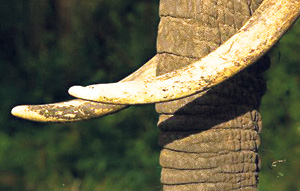During a voyage to Serendib, Sinbad the Sailor is said to have discovered an ancient elephant graveyard, full of elephant tusks. That maybe fictitious, but the Department of Wildlife Conservation (DWC)’s store today resembles a modern elephant graveyard as all the tusks belonging to elephants who die in the wild are kept here.
These tusks are now to be given away on a decision taken by the Minister of Environment and Natural Resources and the first pair of tusks was donated to the President recently.
The decision to give away the tusks has caused some controversy among conservationists with many of the view that this will strengthen the idea of considering elephant tusks as a status symbol.
“This is not a good example set by the Minister of Environment and Natural Resources. It may be true these tusks were from a dead elephant that was not killed for its tusks. But this promotes elephant tusks as a symbol of status,” said one environmentalist who wanted to remain anonymous.
All those who can afford them may want to have a pair of tusks to show their status, and the market for ivory will again be renewed, thus indirectly leading to illegal methods being used to acquire the tusks, it is feared.
Elephants have always been part of our culture and tusks too play a vital role points out Environment Minister Patali Champika Ranawaka who told The Sunday Times there was nothing wrong in donating these tusks that were left in the DWC stores. These tusks that are gathering dust in DWC will now be getting due recognition. “It is a national wealth that shouldn’t be left hidden in the stores. We haven’t done anything wrong by donating tusks to the state,” said the Minister. It is only some activists who could not find fault with the Environment Ministry who are trying to make the donation of tusks a means to criticize the ministry, he says.
If the tusks that were with the DWC shouldn’t be given out, should they be destroyed? This was an issue debated by elephant activists in other parts of the world too. Africa is home to the other species of elephant, that are directly hunted for their tusks. Both male and female African elephants have tusks bigger than that of the Asian Elephants. In 1989, the Kenyan Wildlife Conservation Department had taken a landmark decision to destroy all the ivory piled up in their stores weighing 12 tons. These could have earned a fortune to Kenya, but they burned all their stock under the Convention on International Trade in Endangered Species of Flora and Fauna (CITES). Zambia too followed suit in 1992. It was a brave stand, to show that ivory has no price.
But another group in Africa counter-argued that in a region where people are struggling economically, the precious ivory shouldn’t be collecting dust in warehouses. Why not sell the tusks and channel the funds back into conservation?' With increased demand for ivory from East-Asian countries, subsequently Botswana, Namibia, and Zimbabwe, were permitted to trade limited amount by CITES.
The debate continues, as this week the international media reported the seizure of £20m worth of illegal ivory in south-east Asia, including the third largest haul of elephant tusks on record. Conservationists claim that the decision to allow the sale of ivory to China and Japan could be the reason fuelling a rise in smuggling. They argue that the marketing systems provide loopholes through which poached ivory can enter the legal trade. The report pointed out that about 37,000 African elephants are killed by poachers each year.
Sri Lanka’s problem with ivory is always different. The ivory trade was banned in Sri Lanka in the 1970s, so nobody can keep anything made out of ivory without having a permit. But here in Sri Lanka, poaching for ivory alone is not done like in the African countries. Only 11% of male Asian elephants (Elephas maximus) have tusks. If we assume there are about 4000 elephants in Sri Lanka and the numbers of male elephants are half the number, then the tuskers living in the wildernesses are estimated at around 40-70. This is indeed an alarming situation, if poaching specifically for tusks is done. But they are more likely to fall victim to the human elephant conflict. During the past two years, a few majestic tuskers have been killed and the DWC’s stockpile amounts to about 30 pairs of tusks.
Prof. Charles Santhiapillai’s research into the ivory trade in Sri Lanka in 1999 revealed that the ivory trade was centred in Galle at that time. Ivory carving was popular and done by a group of craftsmen based there. The craftsmen claimed they were using the stocks they had before ivory became an illegal commodity. But Prof. Santhiapillai believes this craft is not pracrised anymore due to the lack of ivory or it having gone underground. He also points out that the more serious threat, facing the Sri Lankan elephant is the human elephant conflict.
There is no doubt that the remaining few tuskers are a national treasure. What is important is to protect them when they are alive, rather than later debate what should be done with their tusks. |

